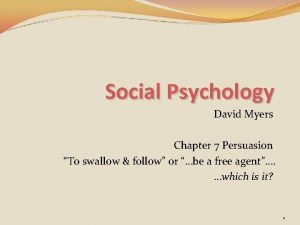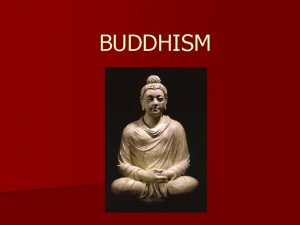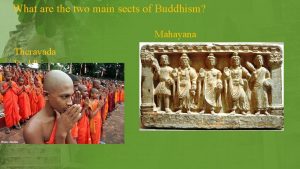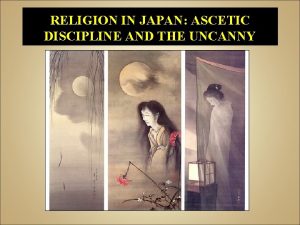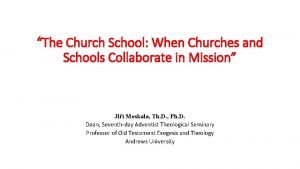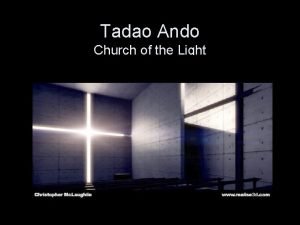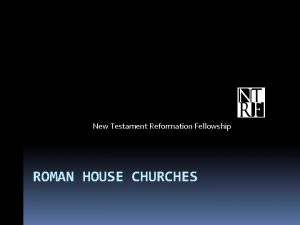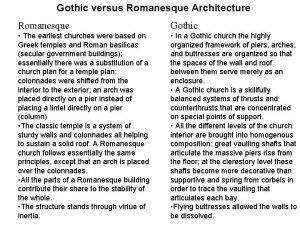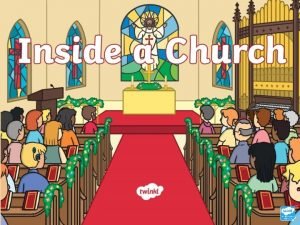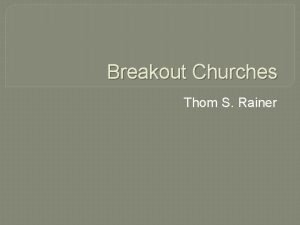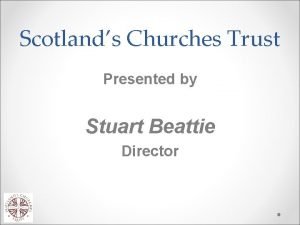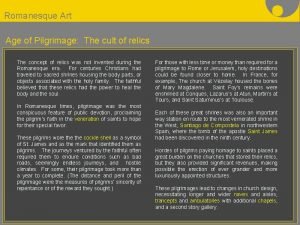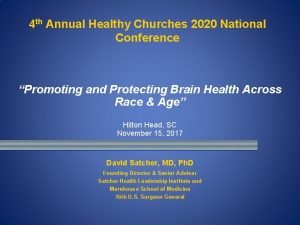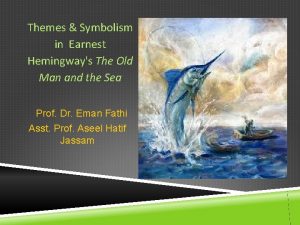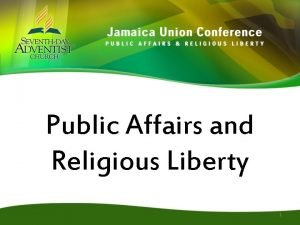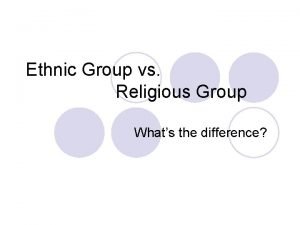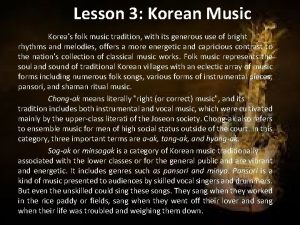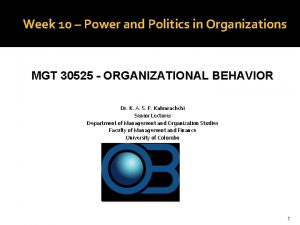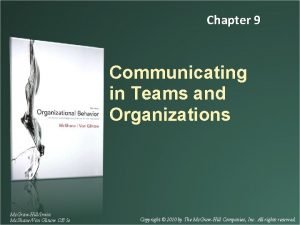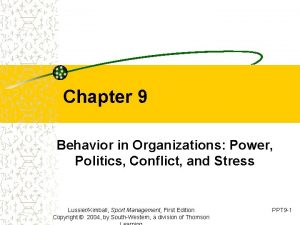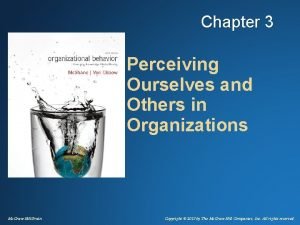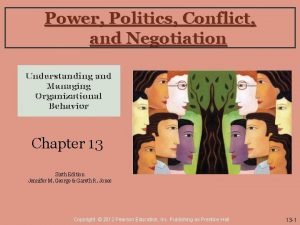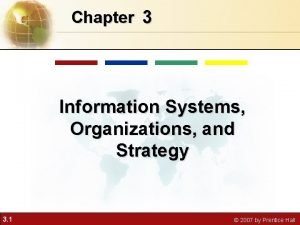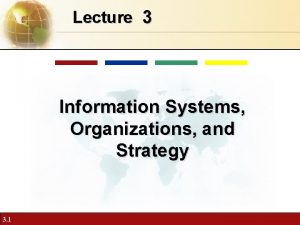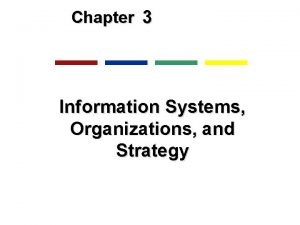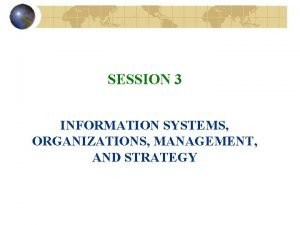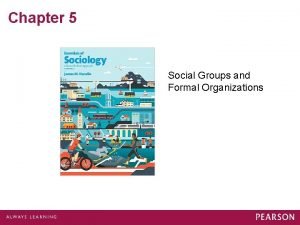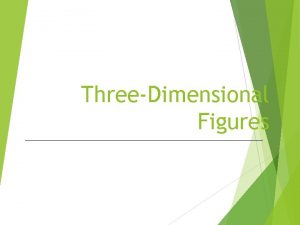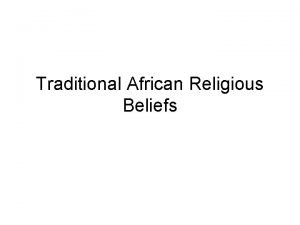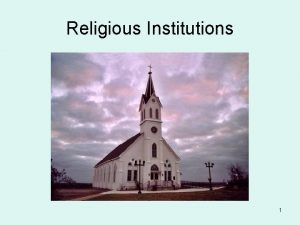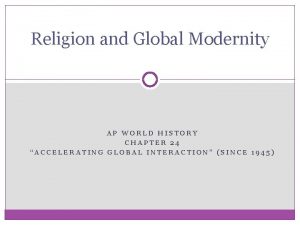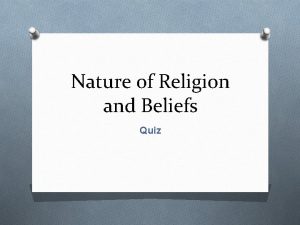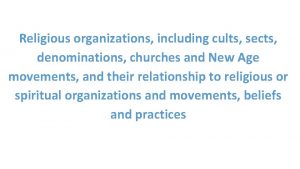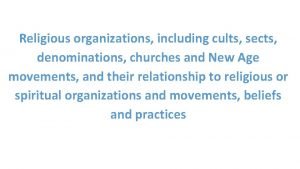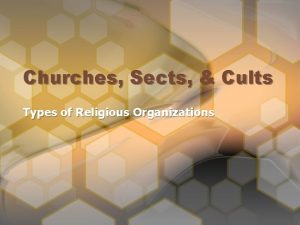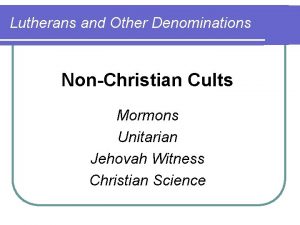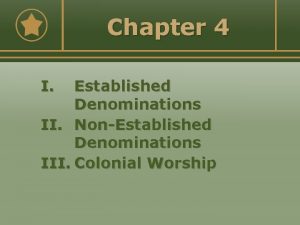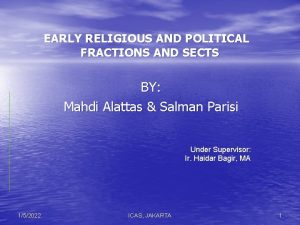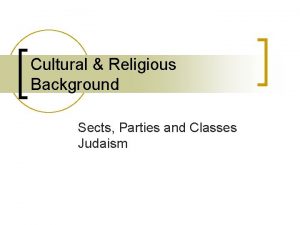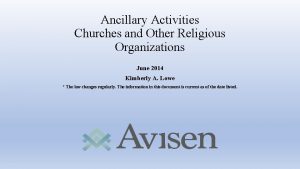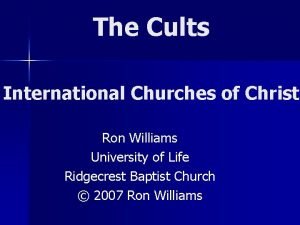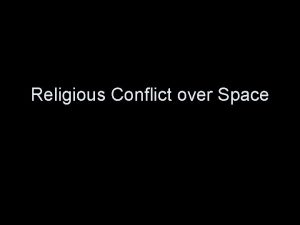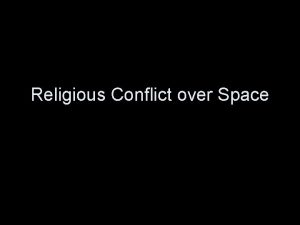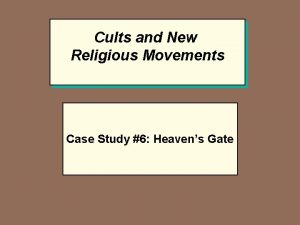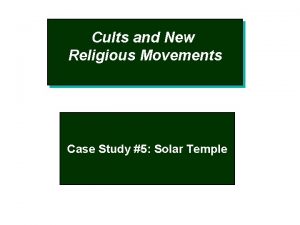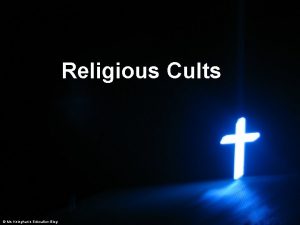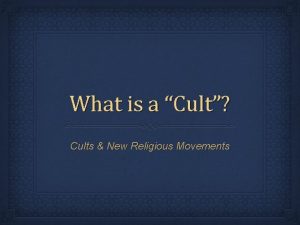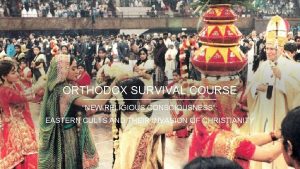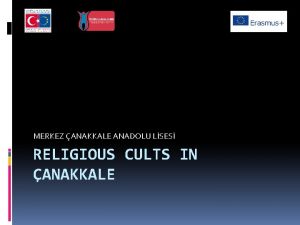Religious organizations including cults sects denominations churches and













































































- Slides: 77

Religious organizations, including cults, sects, denominations, churches and New Age movements, and their relationship to religious or spiritual organizations and movements, beliefs and practices

What is the difference between: 1. A church 2. A denomination 3. A sect 4. A cult

Roy Wallis (1976) - divided organizations into respectable (uniquely legitimate or pluralistically legitimate) or deviant Respectable Deviant Uniquely legitimate Church Sect Pluralistically legitimate Denomination Cult

Church

1. The church - Ernst Troeltsch (1931) – • refers to a large religious organization. • Individuals are born into it. • A church might try to be universal but in reality substantial minorities don’t belong. • It usually ‘stabilizes and determines the political order’. • Churches are often closely related to the state. • Likely to be religiously conservative and support the status quo.

1. The church - Ernst Troeltsch (1931) – Refers to a large religious organization Islam: 2. 1 million; Catholicism: 1. 2 billion; Protestants: 350 million (Anglican church: 100 million)

1. The church - Ernst Troeltsch (1931) – Refers to a large religious organization Case study: Catholicism There are 219, 714 Catholic parishes in 168 countries The Catholic Church owns about 237, 000 acres in America There are 4, 100 priests in Korea There are 8, 847 Roman Catholic schools in France There are 2. 2 million Catholics in Pakistan 3, 500, 000 teachers in 250, 000 Catholic schools worldwide teach 42, 000 pupils

A church might try to be universal but in reality substantial minorities don’t belong.

A church might try to be universal but in reality substantial minorities don’t belong.



Individuals are born into it. Islam Case Study: • The Muslim call to prayer or adhaan ("God is great, there is no God but Allah. Muhammad is the messenger of Allah. Come to prayer. ") are the first words a newborn Muslim baby should hear. They are whispered into the right ear of the child by his or her father. • The baby's first taste should be something sweet, so parents may chew a piece of date and rub the juice along the baby's gums. It was a practice carried out by the Prophet Muhammad and is believed to help tiny digestive systems to kick in. • There a number of events that take place on or after the seventh day. • After seven days the baby's head is shaved (a tradition also carried out by Hindus). This is to show that the child is the servant of Allah. Although Hindus may take the baby's hair to India and scatter it in the holy river Ganges, Muslims weigh it and give the equivalent weight in silver to charity.

It usually ‘stabilizes and determines the political order’.

Churches are often closely related to the state.

Likely to be religiously conservative and support the status quo. New Christian Right: - Anti abortion - Anti gay marriage - Family

Denominations

H. R Niebuhr (1929) – a denomination does not have universal appeal – 2005 – 289, 000 attending Methodists, 287, 600 attending Pentecostal and 254, 800 Baptist. - Denominations are not so closely linked with the upper classes. - Denominations don’t identify with the state - they do not claim a monopoly on religious truth (Steve Bruce – most important distinction) - usually conservative Stark and Bainbridge (1985) – an organization that shares several but not all the supposed features of a church – a watered down church.

Sects

# Sects are groups that are formed as an offshoot of an existing religion. Troeltsch (1981) - Diametrically opposed to the church Smaller and more integrated Connected with the lower classes or at least from those opposed to the state They reject the values of the world Members might be expected to withdraw from the world outside the group They are expected to be deeply committed to their beliefs Members join as adults voluntarily and adopt the lifestyle of the sect – they exercise a stronger control over individuals Monopoly of the truth No hierarchy of paid officials – usually there is one single charismatic leader

Roy Wallis (1976) – views sects as deviant groups which see themselves as uniquely legitimate. Sects tend to break away from the dominant group in society because of a disagreement. Some of these groups which broke away would be accepted as denominations but deviant groups were seen as sects.

Bryan Wilson (1985) Seven different types of sects Conversionist; Revolutionary; Introversionist; Manipulative; Thaumaturgical (miracles/personal messages from God); Reformist; Utopian

Amish: https: //www. youtube. com/watch? v=Ht. NXv. E_r. Lo. E Mormons: https: //www. youtube. com/watch? v=VIao. BHJ 3 m 0 https: //www. youtube. com/watch? v=6 udew 9 axmd. M

STARTER: Church, denomination, sect?

STARTER: Church, denomination, sect? An offshoot of an existing religion They reject the values of the world Usually there is one single charismatic leader

STARTER: Church, denomination, sect? • Refers to a large religious organization • individuals are born into it • it usually ‘stabilizes and determines the political order’.

STARTER: Church, denomination, cult? A ‘loosely knit group organized around some common themes and interests but lacking in any sharply defined and exclusive belief system’.

STARTER: Church, denomination, sect? Does not have universal appeal don’t identify with the state usually conservative

Homework case studies

Roy Wallis (1976) – views sects as deviant groups which see themselves as uniquely legitimate. Sects tend to break away from the dominant group in society because of a disagreement. Some of these groups which broke away would be accepted as denominations but deviant groups were seen as sects.

Sect for a generation? Niebuhr (1929) argued that sects are unlikely to last more than one generation because: • The children of members would not have the fervor of their parents • Sects rely on a charismatic leader so when he/she dies… • The ideology of many sects contain the seeds of their own destruction A good example of a sect changing to a denomination is the Methodists. When it rose in status and membership, the strict disciplines and its rejection of society was dropped… Mass suicide – People’s Temple, the Branch Davidians and the Heaven’s Gate group.

Sect for a generation? • Bryan Wilson (1966) rejects this. • Some sects last a long time (Amish, the Quakers, Mormons etc…) without becoming denominations. • Only one type (conversionist sect) is likely to become a denomination – evangelicals. • Adventist sects (separate from the world) cannot maintain their principles as a denomination – Seventh Day Adventists and Jehovah’s Witnesses.

The People’s Temple – 1970 s – just 900 members; mixed membership including affluent whites and impoverished black Americans – based upon a Marxist philosophy – Jim jones moved the sect to Guyana and set up a commune – 1978, entire sect died after taking cyanide (some committed suicide, others murdered by being tricked into taking the poision). https: //www. youtube. com/watch? v=yd. HRESPj. Bxg

Branch Davidians Waco commune – 1990 s – David Koresh – demanded absolute loyalty – 1993 Bureau of Alchohol, Tobacco and Firearms tried to search the premises but were met by gunfire – Four ATF members died and 16 wounded. The FBI tried to arrest those inside but a fire started and 80 sect members died – the fire was started by the sect. https: //www. youtube. com/watch? v=t 0 j. TEzyf 1 yc

Events Politics Movements Attitudes DESCRIBE THE 1960 s

Roy Wallis: The Elementary Forms of New Religious Life (1984) From the early 60’s, there was a large growth of the number of religious organisations in society. Many of them didn’t fit into the traditional churchdenomination-sect-cult typography Wallis coined the term “new religious movement” to cover them. He identifies between three different kinds of NRM.

Roy Wallis: The Elementary Forms of New Religious Life (1984) Three type of NRM: • 1) World-affirming • 2) World-rejecting • 3) World-accommodating

World-rejecting new religious movements Troeltsch – characteristics • A definite conception of God • Ideology is critical of the outside world • In order to find salvation, members have to take a sharp break from conventional life. Organisations such as these act as total institutions (Goffman). • Limited contact with the outside world is broken for fundraising and spreading the word • Many are puritanical • Vary massively in size • Mainly based around a communal lifestyle

World-accomodating new religious movements • Often breakaways from existing mainstream groups such as Pentecostalists • They neither accept or reject the world • They focus on religious rather than worldly matters • Members tend to lead conventional lives

World affirming NRMs Accept the world as they see it Can be successful by following dominant life but by adding a spiritual element Non exclusive EG: Transcendental Meditation – based on Hindu faith – Beatles: https: //www. youtube. com/watch? v=h 9 Cz. Jkx. KKd 0

World affirming NRMs Wallis – most world affirming NRMs are cults. Cults are like sects in that they have religious beliefs that are widely regarded as deviant, but, unlike sects, cults tolerate the existence of other religions. Cults are loosely structured, tolerant, and non-exclusive. They have a rapid turnover in membership.

Cults

Bruce (1995) ‘mysticism’ - a highly individualistic expression, varying with personal experiences and interpretations. A cult is a ‘loosely knit group organized around some common themes and interests but lacking in any sharply defined and exclusive belief system’. - Tend to be individualistic - Tolerate other beliefs - Often no concept of heresy because their beliefs are so vague

- Stark and Bainbridge (1985) sees them as novel within a society and that there is an overlap between New Age movements and cults – cults are new religions within a society and are unconnected to existing religions:

1. Audience cults – least organized and involve little face to face contact – usually through mass media – EG: astrology 2. Client cults – more organized and offer services to its clients – scientology claims to clear repressed memories of painful experiences: https: //www. youtube. com/watch? v=H 4 PDZt 74 adg 3. Cult movements – more involvement – single religion only – The Reverend Sun Myung Moon’s Unification Church is one example: • We will look at the Moonies shortly…

Why might you join a cult?

Why have they grown? Weber (1922) – likely to arise amongst marginalized groups who don’t feel they are receiving what they deserve. A theodicy of disprivilege – an explanation of why they are in this situation and how to escape it. Bryan Wilson (1970) war, natural disaster or economic collapse can create fertile ground for sects and cults to emerge.

Why have they grown? • 1960 s – targeting of marginalized groups – Nation of Islam: https: //www. youtube. com/watch? v=rur. GNv. Dn. BV 8 https: //www. youtube. com/watch? v=Zh 7 L 8 u. Ri. W-Q

Starter Unscramble the words ontina of mslai ysecintolog lreateiv nepridvtioa rwdol ffigrmina Essct hiams Evtiand aoragminlnisati

Why have they grown? On the whole, most NRMS are made up of white middle class Americans and Europeans - but Wallis argues that these people are still marginalized in some way.

Why have they grown? • Relative deprivation might explain why these white middle class members join these groups because whilst they are not objectively poor, they might feel poor in comparison to other members in society • (Stark and Bainbridge and Wallis)

Why have they grown? Bryan Wilson (1970) sects and cults develop: • During periods of rapid social change (https: //www. youtube. com/watch? v=W 2 Cv 5 h. Zf. Omk • He gives the example of the Methodist movement which he says was in response to urbanization and industrialization.

Bruce (1995) – Why have they grown? Modernization Secularization Traditional institutions have weakened, so people have sought alternatives. In a more secular world, cults have become more popular - require fewer sacrifices & less commitment than churches & sects.

Why have they grown? NRMs offered potential for a more idealistic, spiritual and caring way of life. Bruce – NRMs are a response to the rationalization of western societies. Jobs offer little fulfillment…

Why have they grown? Wallis (1984): Longer period in education – longer childhood – so more young people with more freedom Technology was believed to be the solution to poverty etc Radical political movements were developing in the 60 s

THE ‘MOONIES’ https: //www. youtube. com/watch? v=y. Cfv. GOe. BJtw

THE MOONIES A dangerous cult? Read the Daily Mirror article and highlight the key points

THE MOONIES The Unification Church goes by the name "Association of Families for Unification and World Peace, " or "Family Federation for World Peace and Unification. " However, the Unification Church operates under numerous names and business fronts.

THE MOONIES Now add a bit of spiritism, a pinch of numerology, a dab of physics and a dash of anti-communism; mix it all together, using a Korean Messiah, and you have the recipe for one of the newest religious movements sweeping America -- the Unification Church, founded by Rev. Sun Myung Moon. James Bjornstad, The Moon Is Not the Son (Bethany Fellowship, 1976).

THE MOONIES Meet Reverend Moon: The charismatic leader

THE MOONIES “Jesus Christ is trying to follow me, my footsteps, all the way. He stayed in Paradise, because he did not marry. But I gave him marriage. Don’t you want to meet the wives of Buddha, Confucius and Muhammad? They sent letters of gratitude to me from spirit world. They pledge that even if their religion disappears, they will follow me. Can you imagine anyone in this world claiming to have married those past saints? The rings I prepared for their marriage cost a great deal per couple. Did I do that because I am crazy? Did I ask you to donate to cover that? ” https: //www. youtube. com/watch? v=2 TNw 2 b. Vkzf. Q

THE MOONIES Eileen Barker (1984) – 7 year longitudinal study – study during media moral panic (see headlines such as ‘Moonies have captured my son’ – focus on how and why people joined the Moonies – verstehen – practised both quantitative and qualitative – triangulation or methodological pluralism – participant observation; in depth interviews; questionnaires

THE MOONIES She found that the Moonies were very inefficient at keeping members; they are not brainwashed; most come from happy and secure backgrounds; usually middle class; many join because the religion offers a solution to their needs; like the warm family atmosphere

THE MOONIES Beckford (1985) interviewed 26 ex members, 35 parents and 26 activists in campaigns against cults. Interested in societal reaction. https: //www. youtube. com/watch? v=HUa. F 0 z 2 r. KY

New Age Movements

Why is it different? New Age spirituality is characterized by an individual approach to spiritual practices and philosophies, and the rejection of religious doctrine and dogma. Feminine forms of spirituality, including feminine images of the divine, such as the female Aeon Sophia in Gnosticism, are deprecated by patriarchal religions

• Age of Aquarius • Akashic records • Alternative medicine • Ancient astronauts • Angels • Animism • Ascended master • Astral projection • Astrology • Atlantis Cosmic ordering Crystal healing Earth Changes Earth mysteries Ecofeminism Energy Environmentalism Faith healing Feng shui

New Age Movements: • 1) Phenomena of the 1980 s and 1990 s • 2) Include elements of traditional religions, but close to cults • 3) Broad in terms of types and level of commitment • 4) Tend to be m/c and female • 5) No formal structure

New Age Movements: Heelas (2008): • 2, 000 activities • 146, 000 practitioners in UK • Many are audience or client cults • Self-spirituality • Detraditonalisation

Bruce highlights three themes: • 1) New Science: NAMs are in conflict and reject claims of science • 2) New Ecology: NAMs see the planet as a living organism, any action • has an impact • 3) New Psychology: NAMs see the ‘self as sacred’

Millenarian Movements • 1) Examples shows how religion may inspire activism and social change • 2) Anticipates immediate collective salvation • 3) Close connection to Christianity • 4) Associate with those in deprived positions • 5) Related to apocalypse

Why new age movements?

THE POSTMODERN AGE? John Drane (1999) - Postmodern society has lost faith in metanarratives - Science has failed to make a better world

THE POSTMODERN AGE? Steve Bruce (1995) - We are in the late modern world - Individualism is the key aim - New age beliefs are often softer beliefs of eastern religions - Few demands on followers - Pick and mix shopping

THE POSTMODERN AGE? Heelas (1996) 1. Source of identity in fragmented world 2. Consumer culture 3. Social change 4. Decline of organized religion

KEY REVISION QUESTIONS 1. 2. 3. 4. 5. 6. 7. 8. 9. What is the difference between a church, denomination, sect or cult Why are sects and cults considered deviant? Why might sects and cults be used as evidence of secularisation? What are three types of cults? What are three types of NRMs according to Wallis? Why are people turning to NRMs? What did Eileen Barker think of the so called Moonies? What are new age religions? Why are people turning to new age religions specifically?

Assess the view that cults, sects and New Age movements are fringe organisations that are inevitably short-lived and of little influence in contemporary society. (33 marks)

Critically examine sociological views of new religious movements in society today. 33 marks
 What is persuasion in social psychology
What is persuasion in social psychology Anabaptist denominations
Anabaptist denominations Christian denomination comparison chart
Christian denomination comparison chart Pope paul iv
Pope paul iv How many sects of buddhism
How many sects of buddhism Buddhism at a glance
Buddhism at a glance Describe the new ideas that protestant sects embraced
Describe the new ideas that protestant sects embraced The two main sects of buddhism are
The two main sects of buddhism are Shinto sects diagram
Shinto sects diagram Agam sutras
Agam sutras Churches and schools working together
Churches and schools working together The diagram shows the position of two churches a and b
The diagram shows the position of two churches a and b Ando church of light
Ando church of light House churches in the new testament
House churches in the new testament What can churches do to help the community
What can churches do to help the community Romanesque vs gothic churches
Romanesque vs gothic churches Where was galatia in the bible
Where was galatia in the bible Nice churches
Nice churches The churches the apostles left behind
The churches the apostles left behind Breakout churches thom rainer
Breakout churches thom rainer Scotland's churches trust
Scotland's churches trust Scottish churches housing action
Scottish churches housing action Historical churches thesis statement
Historical churches thesis statement Andrew churches taxonomia de bloom
Andrew churches taxonomia de bloom Pilgrimage churches romanesque
Pilgrimage churches romanesque D m v r e c o r d c h e c k
D m v r e c o r d c h e c k Noitara
Noitara Healthy churches 2020
Healthy churches 2020 Invertebrates including snails slugs and mussels
Invertebrates including snails slugs and mussels Invertebrates including snails slugs and mussels
Invertebrates including snails slugs and mussels Religious symbolism in the old man and the sea
Religious symbolism in the old man and the sea Religious and classical roots
Religious and classical roots Cognitive and non cognitive religious language
Cognitive and non cognitive religious language Religious imagery in romeo and juliet act 1 scene 5
Religious imagery in romeo and juliet act 1 scene 5 Public affairs and religious liberty
Public affairs and religious liberty What's the difference between ethnic and religious group
What's the difference between ethnic and religious group Used in both the folk and classical court music of korea
Used in both the folk and classical court music of korea How are ethnic groups and religious groups related
How are ethnic groups and religious groups related Hellenic ministry of education and religious affairs
Hellenic ministry of education and religious affairs Greek and roman art similarities
Greek and roman art similarities Power and politics in organizations
Power and politics in organizations Voluntary health and welfare organization examples
Voluntary health and welfare organization examples Compare and contrast business organizations
Compare and contrast business organizations Formal groups fulfill both and functions in organizations.
Formal groups fulfill both and functions in organizations. Persuasive communication
Persuasive communication Power politics and conflict in organizations
Power politics and conflict in organizations Perceiving ourselves and others in organizations
Perceiving ourselves and others in organizations Chapter 1 introduction to management and organizations
Chapter 1 introduction to management and organizations Csusm clubs and organizations
Csusm clubs and organizations Power, politics and conflict in organizations
Power, politics and conflict in organizations Mangalore chemicals and fertilizers parent organizations
Mangalore chemicals and fertilizers parent organizations Inventing and reinventing organizations
Inventing and reinventing organizations Information systems organizations and strategy
Information systems organizations and strategy Information systems, organizations, and strategy
Information systems, organizations, and strategy Information systems, organizations, and strategy
Information systems, organizations, and strategy Cultures and organizations software of the mind
Cultures and organizations software of the mind Information systems organizations and strategy
Information systems organizations and strategy Social groups and formal organizations
Social groups and formal organizations Chapter 3 information systems organizations and strategy
Chapter 3 information systems organizations and strategy Printed words including dialogue
Printed words including dialogue It encompasses several different aspects, including
It encompasses several different aspects, including Ice method of quoting
Ice method of quoting The mutcd states all workers including emergency responders
The mutcd states all workers including emergency responders Animals including humans year 6
Animals including humans year 6 Animal that only eats plants
Animal that only eats plants Animals including humans year 4
Animals including humans year 4 Eight dollars is the price of a movie these days
Eight dollars is the price of a movie these days Billy wigglestick
Billy wigglestick How many faces has a square pyramid
How many faces has a square pyramid Including samuel discussion questions
Including samuel discussion questions Africa animism
Africa animism Religious institutions
Religious institutions What is religious organisation
What is religious organisation Religious fundamentalism definition ap world history
Religious fundamentalism definition ap world history Duplo meaning filipino
Duplo meaning filipino Religious questions
Religious questions Native american religious beliefs
Native american religious beliefs Moral model of disability examples
Moral model of disability examples
